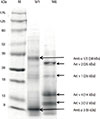1. Lee JW, Choi GS, Kim JE, Jin HJ, Kim JH, Ye YM, et al. Changes in sensitization rates to pollen allergens in allergic patients in the southern part of Gyeonggi province over the last 10 years. Korean J Asthma Allergy Clin Immunol. 2011; 31:33–40.
2. Oh JW, Lee HB, Kang IJ, Kim SW, Park KS, Kook MH, et al. The revised edition of Korean calendar for allergenic pollens. Allergy Asthma Immunol Res. 2012; 4:5–11.

3. Oh JW. Development of pollen concentration prediction models. J Korean Med Assoc. 2009; 52:579–591.

4. Oh JW, Kang IJ, Kim SW, Kook MH, Kim BS, Cheong JT, et al. The association between the concentration of pollen and outbreak of pollinosis in childhood. Pediatr Allergy Respir Dis. 2009; 19:4–11.
5. Park SH, Lim DH, Son BK, Kim JH, Song YE, Oh IB, et al. Sensitization rates of airborne pollen and mold in children. Korean J Pediatr. 2012; 55:322–329.

6. Lee JE, Ahn JC, Han DH, Kim DY, Kim JW, Cho SH, et al. Variability of offending allergens of allergic rhinitis according to age: optimization of skin prick test allergens. Allergy Asthma Immunol Res. 2014; 6:47–54.

7. Wopfner N, Gadermaier G, Egger M, Asero R, Ebner C, Jahn-Schmid B, et al. The spectrum of allergens in ragweed and mugwort pollen. Int Arch Allergy Immunol. 2005; 138:337–346.

8. Kim JH, Oh JW, Lee HB, Kim SW, Kang IJ, Kook MH, et al. Changes in sensitization rate to weed allergens in children with increased weeds pollen counts in Seoul metropolitan area. J Korean Med Sci. 2012; 27:350–355.

9. Oh JW. Characteristics of allergic pollen and the pollen amount was recently changed in Korea. Korean J Asthma Allergy Clin Immunol. 2007; 27:1–7.
10. Oberhuber C, Ma Y, Wopfner N, Gadermaier G, Dedic A, Niggemann B, et al. Prevalence of IgE-binding to Art v 1, Art v 4 and Amb a 1 in mugwort-allergic patients. Int Arch Allergy Immunol. 2008; 145:94–101.

11. Moverare R, Larsson H, Carlsson R, Holmquist I. Mugwort-sensitized individuals from North Europe, South Europe and North America show different IgE reactivity patterns. Int Arch Allergy Immunol. 2011; 154:164–172.

12. Han D, Lai X, Gjesing B, Zhong N, Zhang L, Spangfort MD. The specific IgE reactivity pattern of weed pollen-induced allergic rhinitis patients. Acta Otolaryngol. 2011; 131:533–538.

13. Katial RK, Lin FL, Stafford WW, Ledoux RA, Westley CR, Weber RW. Mugwort and sage (Artemisia) pollen cross-reactivity: ELISA inhibition and immunoblot evaluation. Ann Allergy Asthma Immunol. 1997; 79:340–346.

14. Hirschwehr R, Heppner C, Spitzauer S, Sperr WR, Valent P, Berger U, et al. Identification of common allergenic structures in mugwort and ragweed pollen. J Allergy Clin Immunol. 1998; 101(2 Pt 1):196–206.

15. Weber RW. Patterns of pollen cross-allergenicity. J Allergy Clin Immunol. 2003; 112:229–239.

16. Park HS, Kim MJ, Moon HB. Antigenic relationship between mugwort and ragweed pollens by crossed immunoelectrophoresis. J Korean Med Sci. 1994; 9:213–217.

17. Asero R, Wopfner N, Gruber P, Gadermaier G, Ferreira F. Artemisia and Ambrosia hypersensitivity: co-sensitization or co-recognition? Clin Exp Allergy. 2006; 36:658–665.

18. Yoon MG, Kim MA, Jin HJ, Shin YS, Park HS. Identification of immunoglobulin E binding components of two major tree pollens, birch and alder. Allergy Asthma Respir Dis. 2013; 1:216–220.

19. Hao GD, Zheng YW, Gjesing B, Kong XA, Wang JY, Song ZJ, et al. Prevalence of sensitization to weed pollens of Humulus scandens, Artemisia vulgaris, and Ambrosia artemisiifolia in northern China. J Zhejiang Univ Sci B. 2013; 14:240–246.

20. Jahn-Schmid B, Hauser M, Wopfner N, Briza P, Berger UE, Asero R, et al. Humoral and cellular cross-reactivity between Amb a 1, the major ragweed pollen allergen, and its mugwort homolog Art v 6. J Immunol. 2012; 188:1559–1567.

21. Jahn-Schmid B, Kelemen P, Himly M, Bohle B, Fischer G, Ferreira F, et al. The T cell response to Art v 1, the major mugwort pollen allergen, is dominated by one epitope. J Immunol. 2002; 169:6005–6011.

22. Jimeno L, Duffort O, Serrano C, Barber D, Polo F. Monoclonal antibody-based ELISA to quantify the major allergen of Artemisia vulgaris pollen, Art v 1. Allergy. 2004; 59:995–1001.

23. Himly M, Jahn-Schmid B, Dedic A, Kelemen P, Wopfner N, Altmann F, et al. Art v 1, the major allergen of mugwort pollen, is a modular glycoprotein with a defensin-like and a hydroxyproline-rich domain. FASEB J. 2003; 17:106–108.

24. Canis M, Becker S, Groger M, Kramer MF. IgE reactivity patterns in patients with allergic rhinoconjunctivitis to ragweed and mugwort pollens. Am J Rhinol Allergy. 2012; 26:31–35.

25. Gadermaier G, Wopfner N, Wallner M, Egger M, Didierlaurent A, Regl G, et al. Array-based profiling of ragweed and mugwort pollen allergens. Allergy. 2008; 63:1543–1549.











 PDF
PDF ePub
ePub Citation
Citation Print
Print



 XML Download
XML Download